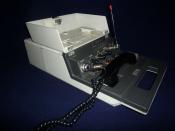Motorola Inc.
April 2004
TM 583 - Strategic Management of Technology
Professor Jack Probst
Dan Nelson
Table of Contents
I. Background Development 1
History/Financial Portfolio 1
II. Analysis of Current Situation 4
Industry Environment 4
Operating Environment 5
Internal Environment 6
Organizational Aspects 6
Marketing Aspects 6
Personal Communications Segment 7
SWOT Analysis 7
III. Core Competencies 8
Wireless 8
Broadband 8
Automotive 8
Embedded Electronic Products 9
IV. Technology Innovation 9
V. External/Competitive Impact 11
VI. Innovative Capacity and Capability 12
Research and Development 12
HiPerMOS Technology 13
Magnetoresistive Random Access Memory (MRAM) Memory Technology 13
Radio Frequency/Intermediate Frequency (RF/IF) silicon technologies 13
SMARTMOS Power Technology 13
VII. Project Development Strategy 14
Innovation and Marketing at Motorola 14
VIII. Recommendation 16
Operating Environment 17
Organizational Aspects 17
Marketing Aspects 18
REFERENCES 20
I. Background Development
"Motorola: a Final Stage Corporation introducing an Initial Stage product innovation with the Mobile Extreme Convergence (MXC) architecture for mobile technology."
The company that I chose to complete my Strategic Analysis on is Motorola Inc.. Many of us are familiar with Motorola products due to the advent of the cellular phones. Regardless of the carrier of the service, be it Verizon, AT&T, Sprint, many of these companies use a cellular device created by Motorola. However, the company does much more than just producing cell phones. One area that Motorola is trying to focus its current strategic actions in the area of Semiconductors.
History/Financial Portfolio
Motorola Inc. started with the founding of the company by Paul V.Galvin (figure 1). Paul and his brother Joseph E .Galvin purchased a battery eliminator business from Stewart Storage Battery Company which made battery eliminators used in operating radios using household current in 1928 and created 'Galvin Manufacturing Company'. The company started with five employees and grew gradually. It expanded...


